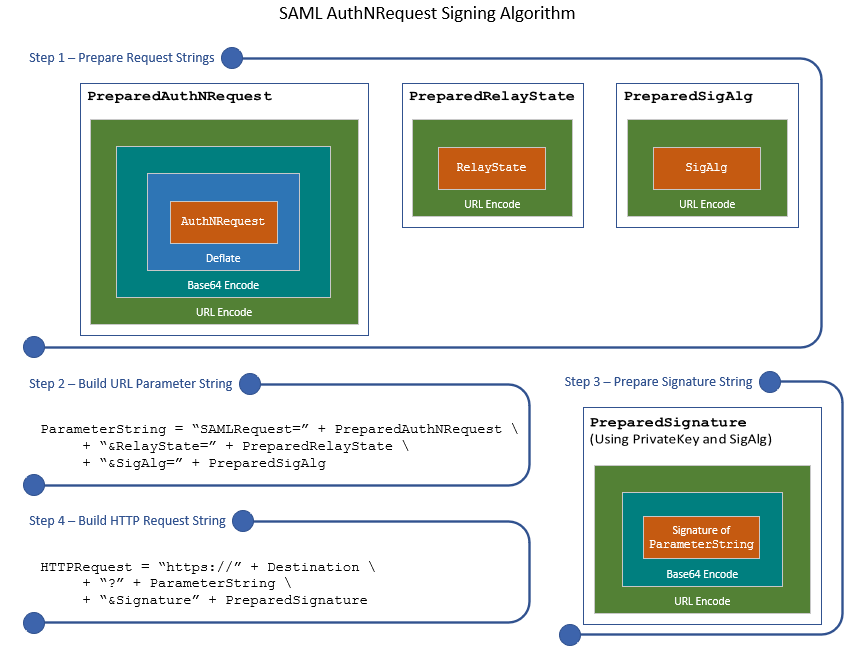I'm receiving a SAML request via HTTP-redirect binding the content of the SAML request look like this
{"SigAlg"=>"http://www.w3.org/2000/09/xmldsig#rsa-sha1", "SAMLRequest"=>"lVLLaoQwFP0VyT5jEqPG4AiFoSDMtNApXXQzxDxaQRObRDqfX3XoolAKXd7DPQ/uuXUQ4zDxo3tzc3zSH7MOMWkPe3DpcixzVVVQl4RBqoiCncEYEmkoY7k00hCQvGgfemf3gOwQSNoQZt3aEIWNC4RwCRGGiD6jkmPMs2KHUPYKksPi0lsRN+Z7jFPgafqpvejtbtQpSK7jYAPfsu3B7C13IvSBWzHqwKPk57vTkS+WfPIuOukG0NSbub9R/yaJELRfzUGzrhmtFut15qdeeheciY926K2u05toUz8sIu0huXd+FPFv9RXpFTTbKp/WA4WobQT/jEYrykwhNaQ66yDNMwY7wijEtMCmysqqo6xOb8Ga+tbjWYe1jtYqfW0uCucoYwWCHS3F0kRGoajWTpAiiJRZJRmu01+Y3+CPt2i+AA=="}
It also has a Signature value
WkDaGzC6vPTlzh+EnFA5/8IMmV7LviyRh2DA5EHF0K0nl+xzBlKfNCYRnunpwoEvGhereGdI5xBpv+mc9IguiCaLZSZjDh6lIDdpvctCnmSNzORqzWQwQGeZ9vjgtCLjUn35VZLNs3WgEqbi2cL+ObrUDS2gV1XvBA3Q3RRhoDmi+XE89Ztnd1cNpR3XdA+EL2ENbMI2XAD9qSgMufUJY/3GBBpT7Vg1ODtPxBudq+sXrgPh/+WtUUitLkkfC8tdRTCS1EZPv+h27I5g/VNza23Xl8w2HdAuYP0F2FjREo8VV2aUtaOUd/jAF9+bfkGV93y1PzFttLxdBbFoxp6qBg==
But I fail to understand how to verify this signature is correct.
Section 3.4.4.1 on SAML binding https://docs.oasis-open.org/security/saml/v2.0/saml-bindings-2.0-os.pdf
To construct the signature, a string consisting of the concatenation of the RelayState (if present),
SigAlg, and SAMLRequest (or SAMLResponse) query string parameters (each one URLencoded)
is constructed in one of the following ways (ordered as below):
SAMLRequest=value&RelayState=value&SigAlg=value
SAMLResponse=value&RelayState=value&SigAlg=value
I tried the approach but
The signature I generated using the Private key does not match to the one I received from my SP. (posted above)
Also, I'm not able to decrypt the signed message using the Private key (I'm assuming the Signature was created using the public that I federated it with.)
<samlp:LogoutRequest ID="_36167d94-d868-4c04-aee3-8bbd4ed91317" Version="2.0" IssueInstant="2017-01-05T16:21:55.704Z" Destination="https://werain.me/" xmlns:samlp="urn:oasis:names:tc:SAML:2.0:protocol"><Issuer xmlns="urn:oasis:names:tc:SAML:2.0:assertion">urn:federation:MicrosoftOnline</Issuer><NameID Format="urn:oasis:names:tc:SAML:2.0:nameid-format:persistent" xmlns="urn:oasis:names:tc:SAML:2.0:assertion">4948f6ce-4e3b-4538-b284-1461f9379b48</NameID><samlp:SessionIndex>_eafbb730-b590-0134-a918-00d202739c81</samlp:SessionIndex></samlp:LogoutRequest>Any help here.


LogoutRequestnot SAMLAuthRequest(I guess I forget to mention that). Second The binding is HTTP redirect and not HTTP-POST see SECTION 3.4.4.1 of SAML bindings. – Prescription